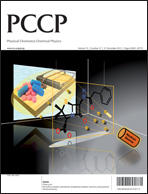Copper–indium–selenide quantum dot-sensitized solar cells†
Abstract
We present a new synthetic process of near infrared (NIR)-absorbing copper–indium–selenide (CISe) quantum dots (QDs) and their applications to efficient and completely heavy-metal-free QD-sensitized solar cells (QDSCs). Lewis acid–base reaction of metal iodides and selenocarbamate enabled us to produce chalcopyrite-structured CISe QDs with controlled sizes and compositions. Furthermore, gram-scale production of CISe QDs was achieved with a high reaction yield of ∼73%, which is important for the commercialization of low-cost photovoltaic (PV) devices. By changing the size and composition, electronic band alignment of CISe QDs could be finely tuned to optimize the energetics of the effective light absorption and injection of electrons into the TiO2 conduction band (CB). These energy-band-engineered QDs were applied to QDSCs, and the quantum-confinement effect on the PV performances was clearly demonstrated. Our best cell yielded a conversion efficiency of 4.30% under AM1.5G one sun illumination, which is comparable to the performance of the best solar cells based on toxic lead chalcogenide or cadmium chalcogenide QDs.


 Please wait while we load your content...
Please wait while we load your content...